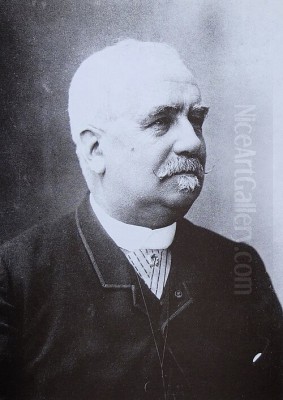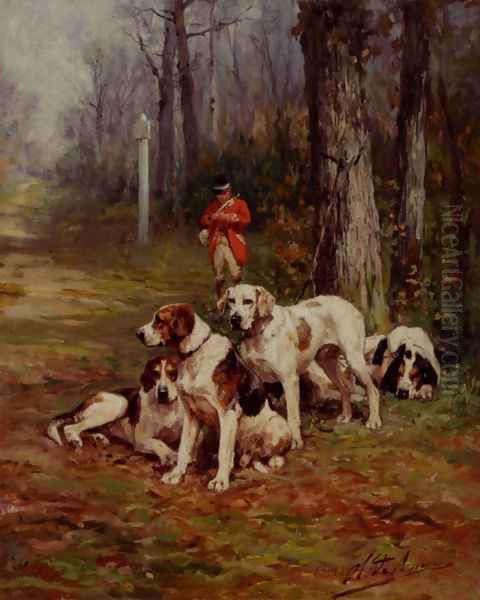Introduction: An Artist of Transition

Charles Olivier de Penne (1831–1897) stands as a notable figure in nineteenth-century French art, particularly associated with the influential Barbizon School. Born in Paris, his artistic journey reflects a common trajectory for many artists of his time: an initial grounding in the academic tradition followed by a gravitation towards the burgeoning ideals of Realism and Naturalism. While he began his career focusing on historical subjects, De Penne ultimately found his true calling in the depiction of landscapes, animals, and, most distinctively, the dynamic energy of the hunt. His work captures a specific facet of the Barbizon spirit, one that celebrates the untamed aspects of nature and the relationship between humans, animals, and the sylvan environment.
Early Career and Academic Roots
Like many aspiring French artists of the mid-19th century, De Penne initially sought recognition within the established academic system. His early training equipped him with the technical skills necessary to tackle complex compositions, leading him to focus on historical painting – a genre highly esteemed by the French Académie des Beaux-Arts. Evidence of his ambition within this system is his participation in the prestigious Prix de Rome competition in 1857. While he did not secure the coveted first prize, which would have granted him years of study in Rome, he was awarded a second prize, a significant accomplishment indicating his considerable talent and potential as recognized by the academic authorities of the day. This early phase, though eventually superseded, laid the foundation for the meticulous draftsmanship and compositional structure evident even in his later, more naturalistic works.
The Call of Barbizon: A Shift Towards Nature

The mid-nineteenth century witnessed a powerful shift in artistic sensibilities, with many painters turning away from the idealized subjects of Neoclassicism and Romanticism towards a more direct engagement with the contemporary world and the natural landscape. The village of Barbizon, situated near the vast Forest of Fontainebleau, became a crucible for this new movement. Artists flocked there to paint en plein air (outdoors), seeking to capture the fleeting effects of light and atmosphere and to depict rural life and landscapes with unvarnished honesty. Key figures like Théodore Rousseau, Jean-François Millet, Charles-François Daubigny, and Jean-Baptiste-Camille Corot were central to this school, each bringing their unique perspective to the shared goal of truthful representation.
Charles Olivier de Penne was drawn into this orbit. He gradually abandoned the historical narratives that marked his early work, finding greater inspiration in the forests, fields, and fauna surrounding Barbizon. This transition aligned him with the core tenets of the Barbizon School: a deep reverence for nature, a commitment to direct observation, and a desire to portray the world with authenticity. While perhaps less focused on the peasant life that characterized Millet's work, De Penne wholeheartedly embraced the landscape itself and the creatures that inhabited it.
Master of the Hunt and Animal Painting
De Penne carved a distinct niche for himself within the Barbizon milieu through his specialization in animal painting (peinture animalière) and, particularly, scenes of the hunt. This subject matter allowed him to combine his skill in depicting landscapes with his keen observation of animal anatomy and movement. His canvases often burst with energy, capturing the thrill of the chase: packs of hounds in full cry, horses straining, and the quarry – typically deer or boar – navigating the dense forest terrain.
His approach was characterized by careful attention to detail. The musculature of the dogs, the textures of animal fur and horse hides, the specific foliage of the Fontainebleau forest – all were rendered with a convincing realism. He possessed a remarkable ability to convey the dynamic motion and inherent wildness of the animals, setting his work apart. Unlike some animal painters who presented static portraits, De Penne excelled at capturing animals in action, integrated naturally within their environment. This focus made him one of the preeminent painters of the hunt in his generation, a genre popular with certain segments of society but requiring specific observational skills.
Notable Works and Artistic Style
Among his well-regarded works, The Deer Hunt (Le Hallali du Cerf) exemplifies his strengths. Such paintings typically showcase a dramatic moment within the hunt, often the point where the hounds have cornered the stag. De Penne masterfully orchestrates these complex scenes, balancing the numerous figures of dogs, horses, and riders within an atmospheric forest setting. The interplay of light filtering through the trees, the sense of rapid movement, and the palpable tension of the event are hallmarks of his best works in this genre.
Sources also mention specific watercolor works, such as Tanner in the Forest of Fontainebleau and Berne on the Western Railway Line. While less common than his oils perhaps, these indicate his versatility across mediums and his continued interest in depicting scenes rooted in specific locations, blending landscape and genre elements. His overall style remained grounded in realism, less experimental perhaps than the Impressionists who followed, but perfectly suited to the accurate and lively portrayal of his chosen subjects. His brushwork, while detailed, often retained a certain vigour appropriate to the dynamic scenes he depicted. He shared with other Barbizon painters like Constant Troyon, also known for his animal depictions, a commitment to naturalistic representation.
Recognition within the Art World: Salons and Awards
Despite the Barbizon School's often anti-establishment stance, many of its members, including De Penne, sought and achieved recognition through the official channels of the Paris Salon and the later Salon des Artistes Français. De Penne was a regular exhibitor, presenting his works to a wide public and the critical scrutiny of the jury. His consistent participation underscores his professionalism and his desire to engage with the mainstream art world.
His efforts were rewarded with several official accolades, testifying to the esteem in which his work was held. He received a bronze medal at the Salon in 1872, followed by a more prestigious silver medal in 1883. Further cementing his reputation, he was awarded another silver medal at the Exposition Universelle (World's Fair) held in Paris in 1889. These awards not only brought him personal recognition but also validated his chosen specialty – animal and hunting scenes – within the broader context of French art, demonstrating that naturalistic depictions of such subjects could achieve critical success alongside historical, mythological, or purely landscape works.
Contemporaries and Artistic Milieu
Charles Olivier de Penne operated within a rich and diverse artistic landscape. His association with the Barbizon School placed him in the company of its leading figures – Rousseau, Millet, Daubigny, Corot, and others like Narcisse Virgilio Díaz de la Peña. While sharing their commitment to naturalism, his focus on the hunt distinguished his output. His work can be compared to that of other prominent animaliers of the era, such as the immensely popular Rosa Bonheur, whose meticulous realism in depicting animals earned her international fame.
His connections extended beyond the core Barbizon group. Auction records show his work presented alongside that of fellow Barbizon landscape painter Henri Joseph Harpignies. Contemporary accounts also mention him in relation to artists like Léon Germain Pelouse, another landscape painter often associated with Barbizon and Cernay-la-Ville, and Jean Lachèvre (potentially the poet or another artist of the same name active in the period). Personal connections are also noted; the artist Auguste Jove (perhaps a misspelling or lesser-known figure, though some sources suggest a connection or confusion with the later animal sculptor Paul Jouve, who was reportedly a neighbor) served as a witness at De Penne's wedding, indicating social ties within the artistic community. These interactions and comparisons help situate De Penne within the complex network of artists working in and around Paris and Barbizon during the latter half of the 19th century. His work engaged with the prevailing trend towards realism championed by figures like Gustave Courbet, albeit applied to a different range of subjects.
A Note on Historical Nomenclature
It is important to distinguish Charles Olivier de Penne, the 19th-century painter (1831-1897), from a historical figure bearing a similar name: Olivier de Penne, a medieval lord associated with the Château de Penne in the Tarn region of Southern France. This earlier Olivier de Penne was involved in the events of the Albigensian Crusade in the early 13th century, notably resisting the crusading forces led by Simon de Montfort and aligning himself with Pierre II of Aragon. The historical anecdotes concerning Penne Castle, the Cathars, and the Crusades pertain to this medieval nobleman and have no connection to the life or work of the Barbizon painter discussed here. The similarity in names is purely coincidental.
Legacy and Assessment
Charles Olivier de Penne secured a firm place in French art history as a prominent member of the second generation of Barbizon painters and as a leading specialist in animal and hunting scenes. While perhaps not as revolutionary as the Impressionists who emerged towards the end of his career, his work represents a significant aspect of 19th-century French naturalism. He successfully blended the Barbizon School's dedication to landscape and direct observation with the specific demands of animal painting and the dynamic narrative of the hunt.
His paintings were appreciated during his lifetime, as evidenced by his Salon medals and consistent exhibition record. They captured a world of vigorous outdoor activity, the beauty and power of animals, and the specific atmosphere of the French forests, particularly Fontainebleau. His work continues to be valued by collectors and institutions interested in the Barbizon School, animal painting, and depictions of traditional sporting life. He remains a testament to the diversity within the Barbizon movement, showcasing how its core principles could be applied to a variety of subjects beyond pure landscape or peasant scenes.
Conclusion: A Dedicated Vision
Charles Olivier de Penne's career charts a course from academic aspiration to a dedicated engagement with the natural world, channeled through the lens of the Barbizon School. Forsaking historical epics for the visceral energy of the hunt and the quiet dignity of animals in their sylvan settings, he became a master of his chosen genre. His detailed realism, dynamic compositions, and atmospheric landscapes earned him recognition in his own time and ensure his continued relevance as a significant painter of animals and the sporting life within the broader movement of 19th-century French naturalism. His work offers a window onto the landscapes and pursuits of his era, rendered with skill, passion, and a deep appreciation for the natural world he observed so closely.